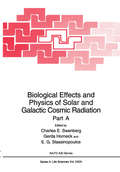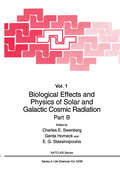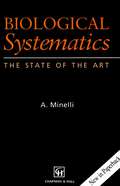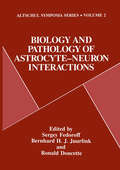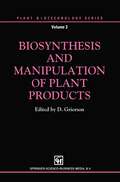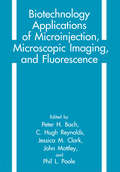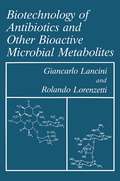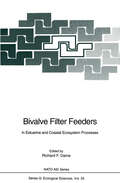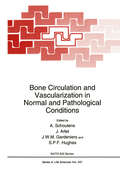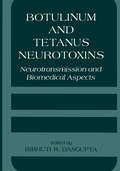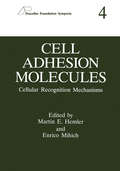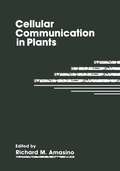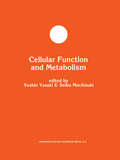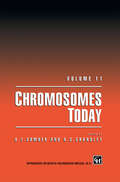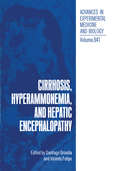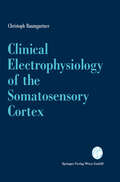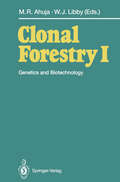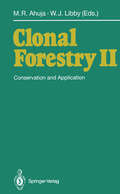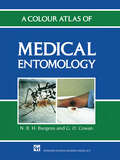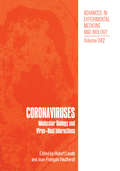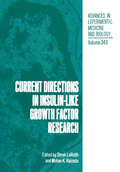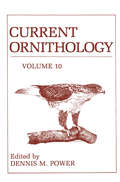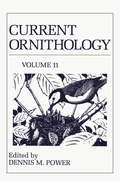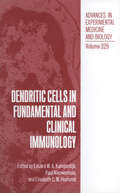- Table View
- List View
Biological Effects and Physics of Solar and Galactic Cosmic Radiation: Part A (Nato Science Series A: #243A)
by Charles E. Swenberg Gerda Horneck E. G. StassinopoulousSpace missions subject human beings or any other target of a spacecraft to a radiation environment of an intensity and composition not available on earth. Whereas for missions in low earth orbit (LEO), such as those using the Space Shuttle or Space Station scenario, radiation exposure guidelines have been developed and have been adopted by spacefaring agencies, for exploratory class missions that will take the space travellers outside the protective confines of the geomagnetic field sufficient guidelines for radiation protection are still outstanding. For a piloted Mars mission, the whole concept of radiation protection needs to be reconsidered. Since there is an increasing interest ci many nations and space agencies in establishing a lunar base and lor exploring Mars by manned missions, it is both, timely and important to develop appropriate risk estimates and radiation protection guidelines which will have an influence on the design and structure of space vehicles and habitation areas of the extraterrestrial settlements. This book is the result of a multidisciplinary effort to assess the state of art in our knowledge on the radiation situation during deep space missions and on the impact of this complex radiation environment on the space traveller. ]t comprises the lectures by the faculty members as well as short contributions by the students given at the NATO Advanced Study Institute "Biological Effects and Physics of Solar and Galactic Cosmic Radiation" held in Armacao de Pera, Portugal, 12-23 October, 1991.
Biological Effects and Physics of Solar and Galactic Cosmic Radiation Part B (Nato Science Series A: #243B)
by Charles E. Swenberg Gerda Horneck E. G. StassinopoulousSpace missions subject human beings or any other target of a spacecraft to a radiation environment of an intensity and composition not available on earth. Whereas for missions in low earth orbit (LEO), such as those using the Space Shuttle or Space Station scenario, radiation exposure guidelines have been developed and have been adopted by spacefaring agencies, for exploratory class missions that will take the space travellers outside the protective confines of the geomagnetic field sufficient guidelines for radiation protection are still outstanding. For a piloted Mars mission, the whole concept of radiation protection needs to be reconsidered. Since there is an increasing interest of many nations and space agencies in establishing a lunar base and lor exploring Mars by manned missions, it is both, timely and important to develop appropriate risk estimates and radiation protection guidelines which will have an influence on the design and structure of space vehicles and habitation areas of the extraterrestrial settlements. This book is the result of a multidisciplinary effort to assess the state of art in our knowledge on the radiation situation during deep space missions and on the impact of this complex radiation environment on the space traveller. It comprises the lectures by the faculty members as well as short contributions by the students given at the NATO Advanced Study Institute "Biological Effects and Physics of Solar and Galactic Cosmic Radiation" held in Armacao de Pera, Portugal, 12-23 October, 1991.
Biological Systematics: The state of the art
by Alessandro MinelliTo some potential readers of this book the description of Biological System atics as an art may seem outdated and frankly wrong. For most people art is subjective and unconstrained by universal laws. While one picture, play or poem may be internally consistent comparison between different art products is meaningless except by way of the individual artists. On the other hand modern Biological Systematics - particularly phenetics and cladistics - is offered as objective and ultimately governed by universal laws. This implies that classifications of different groups of organisms, being the products of systematics, should be comparable irrespective of authorship. Throughout this book Minelli justifies his title by developing the theme that biological classifications are, in fact, very unequal in their expressions of the pattern and processes of the natural world. Specialists are imbibed with their own groups and tend to establish a consensus of what constitutes a species or a genus, or whether it should be desirable to recognize sub species, cultivars etc. Ornithologists freely recognize subspecies and rarely do bird genera contain more than 10 species. On the other hand some coleopterists and botanists work with genera with over 1500 species. This asymmetry may reflect a biological reality; it may express a working practicality, or simply an historical artefact (older erected genera often contain more species). Rarely are these phenomena questioned.
Biology and Pathology of Astrocyte-Neuron Interactions (Altschul Symposia Series #2)
by Sergey Fedoroff Bernhard H. J. Juurlink J. Ronald DoucetteThis volume is made up of papers presented at the Second International Altschul Symposium: Biology and Pathology of Astrocyte-Neuron Interactions. The symposium was held in Saskatoon, Canada at the University of Saskatchewn in May, 1992 in memory of Rudolf Altschul, a graduate of the University of Prague and a pioneer in the fields of the biology of the vascular and nervous systems. Dr. Altschul was Professor and Head of the Department of Anatomy at the University of Saskatchewan from 1955 to 1963. The Altschul Symposia were made possible by an endowment left by Anni Altschul and by other contributions. The symposia are held biennially. One of the greatest challenges for present day scientists is to uncover the mechanisms of brain function. Although cellular anatomy of the nervous system has already been well outlined and indeed was delineated by the beginning of the century, experimental analysis of the function of the brain is relatively recent. The framework of the brain is made up of stellate cells, the astrocytes, which are interconnected by means of their processes, thus presenting a meshwork through which the neurons send their axons, accompanied by oligodendrocytes. Microglia are distributed throughout the brain.
Biosynthesis and Manipulation of Plant Products (Plant Biotechnology Series)
by Donald GriersonVolumes I and 2 of this Plant Biotechnology series reviewed fundamental aspects of plant molecular biology and discussed production and analysis of the first generation of transgenic plants of potential use in agriculture and horticulture. These included plants resistant to insects, viruses and herbicides, which were produced by adding genes from other organisms. Realisation of the potential of plant breeding has led to a resurgence of interest in methods of altering the structure, composition and function of plant constituents, which represents an even greater challenge and offers scope for improving the quality of a wide range of agricultural products. This, in tum, has resulted in a re-evaluation of priorities and targets by industry. Volume 3 of this series considers the biochemical and gentic basis of the biosynthesis of plant products such as starch, lipids, carotenoids and cell walls, and evaluates the ways in which biosynthesis of these products can be modified for use in the food industries. Authors also cover the biosynthesis of rare secondary products and the function and application of proteins for plant protection and therapeutic use. The emphasis throughout is on the relationship between fundamen tal aspects of biosynthesis and structure-function relationships, and application of this knowledge to the redesigning and altering of plant products by molecular genetics.
Biotechnology Applications of Microinjection, Microscopic Imaging, and Fluorescence
by Peter H. Bach C. H. Reynolds J. M. Clark J. Mottley P. L. PooleIndividual cells behave in surpnsmg ways that cannot be deduced from the averaged results of an organ as assessed by the use of conventional biochemical methods. Thus multicellular plant and animals systems are being investigated by an increasing array of histochemical and cytochemical techniques based on general chemical or specific immunological interactions to identify structural materials and to assess biological activities. In recent years there has been an increasing range of fluorescent probes, along with advanced computerised imaging and analysis techniques, which allows the behaviour of individual living cells to be followed in considerable detail. The parallel use of microinjection, microelectrodes and patch-clamping provides additional information about cells and their responses. Recombinant DNA technology has highlighted the desirability and the power of microinjecting defined materials into specific cells and so manipulating their fundamental biochemistry. New hypotheses are being tested which will form the cornerstone of future developments across the whole spectrum of biotechnology. The First European Workshop on Biotechnology Applications of Microinjection, Microscopic Imaging and Fluorescence was run at the University of East London, U.K, 21st-24th April, 1992 with the objective of bringing together a diverse group of individuals who were using these state-of-the-art applications for biotechnological exploration. A novel feature of the meeting was paiticipation by instrument manufacturers in the programme: there were hands-on workshops (where living cells could be examined), combined with the poster sessions.
Biotechnology of Antibiotics and Other Bioactive Microbial Metabolites
by G. Lancini R. LorenzettiIn response to the field's need for an introductory text, the authors have distilled the vast and scattered literature relating to the biotechnology of microbial secondary metabolites. General biology, biosynthesis, the search for novel metabolites, and techniques for strain improvement are all discussed to provide undergraduate and graduate students with a concise, readable overview of the field.
Bivalve Filter Feeders: in Estuarine and Coastal Ecosystem Processes (Nato ASI Subseries G: #33)
by Richard F. DameBivalve filter-feeding mollusks are important components of coastal ecosystems because they remove large quantities of suspended material from the water and excrete abundant amounts of reactive nutrients. These animals are also major prey for numerous predators including birds, fish, mammals, and invertebrates; furthermore, they are significant food resources for humans. While studies on the organismic and population level have dominated bivalve ecology, the recent focus on the ecosystem roles of filter feeding systems has led to larger-scale investigations. With this approach the specific topics of physiology, grazing, predation, nutrient cycling, physical environment, computer simulation modeling, and environmental management are combined into a meaningful whole.
Bone Circulation and Vascularization in Normal and Pathological Conditions (Nato Science Series A: #247)
by A. Schoutens J. Arlet Jean Wm Gardeniers S P F HughesThe Association Internationale de Recherche sur la Circulation Osseuse, A.R.C.O., was founded in London in December 1989 by a small group of doctors, surgeons and researchers in basic sciences who had been involved for many years in the study of bone circulation and its disorders. They had met several times in Toulouse, during the International Symposia on Bone Circulation held there since 1973 and they wished to carry their contacts further. In founding A.R.C.O., they established as their primary aims the encouragement and furtherance of research, organisation of meetings and promotion of knowledge on the subject. At the present time, the Association has over a hundred members from more than bone tissue twenty countries in Europe, America and Asia. All have the conviction that and its pathology can only be truly known and studied if one has an understanding of its vascular system and the way its circulation functions. This concept, apparently beyond question, has not yet been adopted by all physicians and scientists who are interested in bone. From time to time, one comes across teaching programmes on bone patho logy which make no mention of bone circulation.
Botulinum and Tetanus Neurotoxins: Neurotransmission and Biomedical Aspects
by B. R. DasGuptaThree days in Madison have thoroughly modified my view on clostridial neurotoxins. While still realizing the numerous activating, modifying and protective inputs, I cannot judge the meaningfulness of the meeting impartially. Neither may the reader expect a complete summary of all presentations. Collected in this volume, they speak for themselves without requiring an arbiter. Instead I shall write down my very personal opinions as a researcher who has studied clostridial neurotoxins for nearly 25 years. Comparable conferences have been rare during this time. A comprehensive symposium 4 on C. botulinum neurotoxins has been organized at Ft. Detrick. International conferences on tetanus have been held regularly under the auspices of the Wodd Health Organization. One or maximally two days of these meetings have been devoted to tetanus toxin and its actions whereas the sponsor and the majority of the participants have been interested mainly in epidemiology, prevention and treatment of tetanus as a disease (see refs. 5,6). Some aspects of clostridial neurotoxins have been addressed in the context of bacterial toxins, in particular in the biennial European workshops. 1-3,7,8 The Madison meeting differed from the previous ones in three aspects. First, it covered both tetanus and botulinum neurotoxins. The fusion was justified because of their huge similarities in primary structure, in their mode of action and in their cellular targets. Second, the meeting was not limited to toxins but drew some lines on which modern neurobiology might proceed.
Cathedral Cats
by Richard SurmanThe ebook edition of Cathedral Cats that captures the fascinating life stories of cats who make their homes in and around the grandeur of Britain’s cathedrals.
Cell Adhesion Molecules: Cellular Recognition Mechanisms (Pezcoller Foundation Symposia #4)
by Martin E. Hemler and Enrico MihichThe Fourth Annual Pezcoller Symposium entitled Adhesion Molecules: Cellular Recognition Mechanisms was held in Rovereto, Italy, June 24-26, 1992 and was focussed on the detailed mechanisms whereby cells utilize certain integral membrane proteins to perceive their surrounding environment and interact with it. With timely presentations and stimulating discussions this Symposium addressed the genetics and biochemistry of adhesion molecules, the regulation of their functions and their role in cancer and the immune system. Emphasis was given to adhesion proteins in the integrin family because of the widespread distribution of this group of molecules and its important role in essentially all eukaryotic biological systems. The regulation of integrin genes and their expression are discussed in detail, as are specific aspects of the genetics of fibronectin. The molecular basis for the regulation of certain integrins, the function of these proteins in determining cell adhesion, and the consequences of this adhesion for the function of the cells involved are discussed. The role of certain integrins in stimulating signal transduction, the essential involvement of integrins in conditioning the function of T and NK cells function, the heterogeneity of integrins and its biological consequences, and the role of cell adhesion molecules in tumor cells invasion and metastases are all extensively analyzed. New information was presented on the role of CD44 and splice variants in normal differentiation and tumor progression.
Cellular Function and Metabolism (Developments in Molecular and Cellular Biochemistry #9)
by Yoshio Yazaki Seibu MochizukiA variety of metabolic processes are known to be intimately involved in the maintenance of cellular structure and function. It has also become clear that metabolic events involved in the synthesis and hydrolysis of ATP as well as for the synthesis of proteins and phospholipids are essential for cellular health. The regulation of cell function is generally achieved through participation of a wide variety of hormones and different signal transduction mechanisms for the activation/deactivation of some specific metabolic processes. In this regard cyclic AMP and calcium seem to play a crucial role. Various hormones are also known to affect the genetic machinery of all the cell; however, the exact signals for genetic control of cellular function are not well defined. In particular, the sequence of events concerned with remodelling of different types of cells under various pathological situations is poorly understood. In this book we have therefore dealt with some of these issues from biochemical, molecular biological, physiological, and pharmacological viewpoints. Special emphasis has been laid on understanding heart function and metabolism in health and disease in general, and cardiac hypertrophy, heart failure, and ischemic heart disease in particular. It is hoped that this multidisciplinary information will be of value to basic scientists and clinical investigators.
Chromosomes Today: Volume 11
by A. T. Sumner A. C. ChandleyWhen the late Professor C. D. Darlington founded what developed into the International Chromosome Conferences in Oxford in 1964, he was concerned that scientists who worked on different aspects of chromosomes, or who studied them in different ways, should have the opportunity of "discussing the fundamental problems of chromosomes with one another". The fact that well over 300 scientists with a wide variety of interests came to Edinburgh in August 1992 for the 11th International Chromosome Conference shows that there is still the same need, and also the desire among chromosomologists to have such discussions. The present volume contains almost all the invited contributions, and attests to the diversity of approaches and applications in chromosomal studies. A few years ago it may have seemed to some that chromosome studies were being superseded by molecular biology, but the molecular biologists have now realized that they need to know about chromosomes, and indeed an important, if ill-defined discipline of 'molecular cytogenetics' has grown up in recent years. We are pleased that in planning the Conference and this book, so much of the work presented is at the interface between cytogenetics and molecular biology. This will surely continue in the future, as boundaries between disciplines are largely artificial, and each has much to learn from the others.
Cirrhosis, Hyperammonemia, and Hepatic Encephalopathy (Advances in Experimental Medicine and Biology #341)
by Santiago Grisolía Vicente FelipoThis volume contains the papers presented in the International Summer Course on "Cirrhosis, Hyperammonemia and Hepatic Encephalopathy," which was one of the prestigious Summer Course, of the Complutense University of Madrid held in EI Escorial, Spain, during August 10-14, 1992. Liver cirrhosis is one of the main causes of death in western countries. In addition there is a series of liver dysfunctions including fulminant hepatic failure, Reye's syndrome and congenital defects of urea cycle enzymes that could lead to hepatic encephalopathy, coma and death. As a consequence of impaired liver function, the ability to detoxify ammonia by its incorporation into urea is diminshed, resulting in increased ammonia levels in blood and brain. Hyperammonemia is considered one of the main factors in the mediation of hepatic encephalopathy and the classical clinical treatments are directed towards reducing blood ammonia levels. A part of the book is therefore devoted to the study of certain aspects of ammonia metabolism such as the regulation of the urea cycle, the main mechanism of ammonia detoxification in mammals, which is located mainly in the liver. The metabolism of ammonia in other tissues, including brain, is also presented, as well as the effects of hyperammonemia on brain metabolism and function and on brain microtubules. The control of cerebral protein breakdown is reviewed. The classical and some recently proposed clinical treatments as well as nutritional considerations in the management of patients with liver failure are also discussed.
Clinical Electrophysiology of the Somatosensory Cortex: A Combined Study Using Electrocorticography, Scalp-EEG, and Magnetoencephalography
by Christoph BaumgartnerClonal Forestry I: Genetics and Biotechnology
by Mulkh-Raj Ahuja William J. LibbyClonal forestry has come of age. Basic techniques in genetics and biotechnology of other organisms are generally applicable to forest trees. However, there are some differences, in particular in the juvenile- and maturation-related regeneration. Examined here are crucial topics of juvenility, maturation and rejuvenation in clonal propagation of trees. In addition, the genetics of clones, population biology of clonal deployment, propagation and field testing of clones, clone identification, clonal physiology, regeneration and variation in plant tissue cultures, the role of somatic embryogenesis in clonal forestry, and recent developments in biotechnology, including the molecular structure of trees and gene transfer are covered in depth.
Clonal Forestry II: Conservation and Application
by Mulkh-Raj Ahuja William J. LibbyProvided here are both underlying theory and recent results concerning the propagation and use of clones in research and in production forestry. State-of-the-art science and case histories treating production, testing, multiplication and deployment of clones are presented. Agroforestry, urban forestry and christmas-tree farming are covered, along with more traditional multiple-use forestry and high-intensity forestry for biomass, wood and fiber production. Clonal forestry is contrasted to the more recent developments of "family forestry", and the classical tree-improvement approach relying on seed-orchards. The history of clonal forestry is covered with reviews of several centuries experience with Sugi in Japan and poplars in Europe. The impacts and use of clones in the contexts of genetic conservation and biodiversity are discussed, as are the laws and regulations affecting clonal production and deployment.
A Colour Atlas of Medical Entomology
by Nicholas Burgess G.O. CowanA there it is! guide to insects of medical and public health concern, mainly in the tropics. Each chapter covers identification, life cycle and habits of the causative stage and its medical/public health significance.
Coronaviruses: Molecular Biology and Virus-Host Interactions (Advances in Experimental Medicine and Biology #342)
by Hubert Laude Jean-Francois VautherotCoronaviruses represent a major group of viruses of both molecular biological interest and clinical significance in animals and humans. During the past two decades, coronavirus research has been an expanding field and, since 1980, an international symposium was held every 3 years. We organized the yth symposium for providing an opportunity to assess important progresses made since the last symposium in Cambridge (U. K. ) and to suggest areas for future investigations. The symposium, held in September 1992, in Chantilly, France, was attended by 120 participants representing the majOlity of the laboratories engaged in the field. The present volume collects 75 papers which were presented during the yth symposium, thus providing a comprehensive view of the state of the art ofCoronavirology. The book is divided into 7 chapters. The first chapters gather reports dealing with genome organization, gene expression and structure-function relationships of the viral polypeptides. New sequence data about as yet poorly studied coronaviruses - canine coronavirus CCY and porcine epidemic diarrhoea virus PEDY - are presented. Increasing efforts appear to be devoted to the characterization of products of unknown function, encoded by various open reading frames present in the coronavirus genomes or delived from the processing of the large polymerase polyprotein. Due to the extreme size of their genome, the genetic engineering ofcoronavi\'uses through the production of full length cDNA clones is presently viewed as an unachievahle task.
Current Directions in Insulin-Like Growth Factor Research (Advances in Experimental Medicine and Biology #343)
by Mohan K. Raizada DerekRoithThe study of the insulin-like growth factor (IGF) family has become an exciting area of investigation. Initially, this family consisted of ligands (insulin, IGF-I and IGF-m and receptors (the insulin receptor, the type I or IGF-I receptor and the type II or IGF-IYM-6-P receptor). Subsequently, it was discovered that six specific binding proteips (lGFBPs 1-6) playa major role in the actions of this growth factor family. In addition, there are now more potential receptors when one considers the possible roles of the insulin-receptor related receptor (IRR) and hybrid receptor dimers composed of insulin and IGF-I receptor (half-receptors). Another important aspect of this area of research is the realization that the IGFs are not only essential for normal growth and development but, in addition play an important role in the normal specialized function(s) of all tissues of the body, including the nervous system, skeleton, reproductive system, kidney, and the immune system, to name but a few. The development of recombi!tant human IGF-I for clinical testing has been a major breakthrough for investigators. Potential uses include wound healing, reversal of catabolic states, diabetes, bone remodeling, recovery from acute renal failure and many others. will determine both its use and its potential hazards.
Current Ornithology: Volume 10 (Current Ornithology #10)
by D. M. PowerDetailing novel research methods, this compilation presents major advances in fundamental aspects of phylogeny, mating, parental care, the trophic structure of Raptor communities, demography, behavioral ecology, species diversity, and the evolution of avian ontogenies. The book also features the most extensive list of international references available on raptor diet and feeding behavior and nocturnality. Current Ornithology is the only English-language publication currently devoted exclusively to extensive reviews and synthesis of topics pertaining to all aspects of the biology of birds. Chapters fall under such diverse rubrics as ecology, evolution, behavior, phylogeny, behavioral ecology, anatomy and physiology, and conservation biology. All authors are leading authorities on their subjects, and each chapter is refereed by experts in the topics covered. Although all chapters focus primarily on birds, some topics, such as the social cognition of birds as compared to primates (Volume 13), have significant application to disciplines outside of ornithology. Current Ornithology aims to provide an accessible, up-to-date, accurate source of data and to contribute to conceptual generalization and unification across the biological sciences.
Current Ornithology: Volume 11 (Current Ornithology #11)
by Dennis M. PowerThis is the only English-language publication devoted exclusively to extensive reviews and synthesis of topics on the biology of birds. The current volume includes articles on sibling competition, predation and the limitation of bird numbers, and population trends in birds of eastern North America.
Dendritic Cells in Fundamental and Clinical Immunology (Advances in Experimental Medicine and Biology #329)
by Paul Nieuwenhuis Eduard W. A. Kamperdijk Elizabeth C. M. HoefsmitThese Proceedings contain the contributions of the participants of the Second International Symposium on Dendritic Cells that was held from the 1st to 25th of June 1992 in Amsterdam, the Netherlands. The First International Symposium on Dendritic Cells was organized as a Satellite symposium at the occasion of the 30th anniversary of the Japanese Reticuloendothelial Society by Dr. Y. Imai in Yamagata (Japan), in 1990. It was entitled "Dendritic Cells in Lymphoid Tissues," and focused primarily on the Interdigitating Cells (IDC), Epidermal Langerhans cells (LC) and Follicular Dendritic Cells (FDC) , from the point of view of human pathology. However, the concept of Dendritic Cell System, comprising the bone marrow derived IDC and LC but not the FDC, was based on animal experiments and mainly on in vitro experiments on isolated cells. In a report from the Reticuloendothelial Society Committee on Nomenclature in 1982, Tew, Thorbecke and Steinman had already characterized these different types of DC, but the gap between in vivo and in vitro function remained. In Amsterdam, the Symposium focused on the Role of Dendritic Cells in Fundamental and Clinical Immunology. First, recent developments in molecular biology of antigen presentation and cell biological aspects of signal transduction were discussed, in relation to the potential of DC to stimulate lymphocytes and to trigger their in vitro differentiation.
